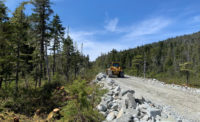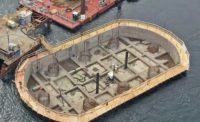Fern Hollow Bridge Emergency Replacement
Pittsburgh
BEST PROJECT, HIGHWAY/BRIDGE
Submitted By: HDR
Owner: PennDOT District 11-0; City of Pittsburgh
Lead Designer: HDR
General Contractor: Swank Construction Co. LLC
Construction Management: Michael Baker International
Lighting Design: Santangelo & Lindsay Inc.
Surveys and Right of Way: Monaloh Basin Engineers
Utilities and Cultural Resources: Markosky Engineering Group Inc.
Structural Beam Fabricator: PennStress
Construction inspection: SAI Consulting Engineers Inc.; CSS Inc.
Subcontractors: Power Contracting Co.; M. O’Herron Co.; Lindy Paving
Before Jan. 28, 2022, few people outside Pittsburgh were familiar with the Fern Hollow Bridge, a half-century-old neighborhood connector that was also a gateway to historic Frick Park, the city’s largest municipal greenspace. But after an early morning structural collapse of the 447-ft-long, three-span steel K-frame structure sent a bus and several passenger cars plummeting approximately 100 ft into a ravine below and injuring 10 people, Fern Hollow was suddenly in the national spotlight—both as a source of relief that a more serious tragedy had been averted and as a symbol of the nation’s deteriorating transportation infrastructure.
Following a visit to the collapse site, President Joe Biden echoed the sentiments of the leaders of Pittsburgh and Pennsylvania by telling an audience at a previously scheduled Pittsburgh speaking engagement that the Fern Hollow Bridge would be rebuilt.

Photo courtesy of HDR
Less than a year later, a smiling group of local, state and federal officials cut a ceremonial ribbon to partially open the new Fern Hollow Bridge, a four-lane, 460-ft, three-span composite prestressed concrete structure designed, permitted and built in under 11 months by a Pennsylvania Dept. of Transportation-led design-build collaboration of HDR Inc., and Swank Construction Co.
While $25.3 million in emergency federal funding from the Infrastructure Investment and Jobs Act and expedited state procurement processes had set the stage for the replacement effort, then-PennDOT Secretary Yassmin Gramian told ceremony attendees that the successful completion of a safe, new bridge in such a short time was “the result of incredible collaboration” by participants at all levels.
To be sure, close working partnerships are critical to any construction project, and the urgency to rebuild the Fern Hollow Bridge precluded use of a normally linear design and construction process. But as an ENR Best Projects judge noted, the replacement project wasn’t just about “blowing through and getting it done as quick as possible” but also “being mindful of it’s going to be there for … 100 years.”

Photo courtesy of HDR
The project team had to weigh many unusual issues and constraints associated with the bridge’s environmentally sensitive location within Frick Park. They included a historic gatehouse shelter designed by noted architect John Russell Pope located adjacent to the western bridge abutment. The team also had to be sensitive to public input, particularly calls to use the replacement effort as an opportunity to increase safety and improve multimodal access through the corridor.
Jason Fuller, HDR project manager, credits PennDOT with setting the tone to tackle the multifaceted challenge by selecting an “experienced, knowledgeable and trusted team that allowed for swift decisions and calculated risks.” That confidence and commitment, in turn, helped expedite the project, Fuller says, “since the agency felt extremely comfortable with how decisions were being developed and made.”

Photo courtesy of HDR
For example, semi-weekly project update meetings proved critical in keeping all team members abreast of multiple concurrent issues, from sourcing materials and fabrication lead times to agency reviews of design concepts. “Everyone attended whether they had a topic on the agenda or not,” Fuller says.
Mike Szurley, PennDOT senior project manager, notes that virtual collaboration tools and processes honed during the COVID-19 pandemic provided much-needed flexibility and time savings.
“The team held several virtual breakout sessions to work through design and construction details and solicit feedback from everyone on the team,” Szurley says. “The ability to [meet] virtually meant we could pull everyone together without the need to travel to solicit feedback.”
Although time was on no one’s side, Chad Basinger, Swank project manager, notes that conducting focused project meetings within the context of a condensed schedule proved to be a benefit.
“The acceleration, in some ways, kept information fresh and relevant,” Basinger says. “There were times where the easy answer to a problem might have been the quickest to get from the drawing board to construction, but might have resulted in a less-than-desirable final product. Because of the prior experience of the team, and the real-time involvement of all interested parties, solutions could be investigated and resolved in short order.”

Photo courtesy of HDR
The team also tackled many logistical issues, including identifying the best way to navigate the new bridge’s 21 8-ft-deep by 152-ft-long PA bulb-tee beams, each weighing more than 200,000 lb, through neighborhood streets to the project site.
To minimize construction activity within the park, the bridge’s two round column piers were founded on 17- to 20-ft-deep, 8.5-ft-dia drilled shafts that Swank self-performed using available tooling. The use of 13-ft-tall, 5.5-ft-wide integral abutments founded on drilled steel piles that were constructed behind the original bridge’s masonry abutments managed to further blend the new structure into the natural setting.
While the new bridge occupies the same 64-ft-wide footprint as its predecessor, the team reallocated the layout to accommodate four travel lanes and a 10-ft wide, shared-use path. A signalized pedestrian and cyclist crossing, funded under a separate grant program, was incorporated into the western bridge approach, eliminating a long-standing hazard for motorists and park users
Since the December 2022 reopening ceremony, HDR/Swank crews have worked to open the other two lanes and apply a 1-in.-thick concrete overlay. The team has also worked with local officials to augment the bridge with public art elements. They include etched railing and sidewalk panels that visually represent the site’s geological history. There also are enhancements to the pedestrian trail, such as sculptures and benches resembling boulders and driftwood, the latter made of trees salvaged from the collapse site.

Photo courtesy of HDR
Fuller reports that while the final costs had yet to be calculated as of ENR MidAtlantic press time, the project will finish below budget and ahead of schedule.
Although the project team was constantly cognizant of the replacement effort’s elevated profile, including extensive media coverage and a second visit by President Biden, Szurley says the heightened attention was never a distraction.
“The team was truly laser-focused on overall project delivery and achieving a positive outcome for the community,” he says.
Yet the project also presented challenges that Basinger says were eagerly embraced by everyone involved—state and federal agencies, the construction industry, local stakeholders and others.
“It was our motivation to get the job done,” he says. “From Day 1 there was a sense of pride around working on the Fern Hollow Bridge project.”




